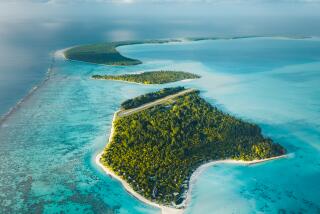Midway not just for the birds
- Share via
THE first time I traveled to Midway Atoll was 1996, a year before the U.S. Naval Air Facility closed. I was strapped into a tail-facing seat in the windowless belly of an Air Force cargo plane.
That blind descent in a backward position, after a long flight northwest from Honolulu into a part of the Pacific typically painted empty blue on maps, was my first experience of what I came to call “Midway syndrome.” The symptoms -- odd but exhilarating dislocations of the time-space continuum -- seem to occur regularly on this far-flung Hawaiian landfall.
For the record:
12:00 a.m. March 25, 2007 For The Record
Los Angeles Times Sunday March 25, 2007 Home Edition Travel Part L Page 3 Features Desk 1 inches; 42 words Type of Material: Correction
Hawaiian National Monument -- An article about the newly created Northwestern Hawaiian Islands Marine National Monument (“Midway Not Just for the Birds,” March 18) incorrectly reported the size of the monument. It has 4,500 square miles of coral reef, not 4,500 acres.
Planes arrive at Midway after dark, when its legions of seabirds have settled in for the night, so I stepped down onto the runway in front of a huge hangar lighted up like a stage set, surrounded by primordial darkness. Huge anchors flanked the building’s portal. The hall inside was lined with 500-pound torpedo casings painted Easter-egg colors.
Moments later, my baggage and I were being ferried in a golf cart along a narrow road, and the dark fields on each side seethed with motion and echoed with strange sounds. Midway’s largest aboriginal population was at the height of its breeding season, and the cart’s headlights revealed them: a white sea of rooster-sized Laysan albatrosses, all engaged in a frenzy of socializing.
By the time I reached my quarters in a former officers barracks, rather banally refurbished but still bearing a sense of spit and polish and 1950s time warp, I was pinching myself.
Once a military outpost, always an invaluable ark for wildlife, Midway will soon become a travel destination -- with a few caveats, of course. As the most accessible part of the recently pronounced Northwestern Hawaiian Islands Marine National Monument, established in 2006 by President Bush, Midway is about to open the doors to a small-scale visitor program managed by the U.S. Fish & Wildlife Service.
The national monument stretches 1,200 miles northwest of the main Hawaiian Islands. Its astounding wealth of endemic land and sea species has earned it the moniker “Hawaiian Galapagos.” Most of the monument is underwater, a wilderness of some 4,500 acres of coral reef. A mere 6 square miles are islands and atolls, and most of these landfalls are crucial refuges for huge colonies of seabirds and endemic Hawaiian flora and fauna and will remain closed to the public.
Midway is the exception. In December, the Fish & Wildlife Service released a draft of a plan that, if all goes accordingly, will open the atoll to a small number of visitors in the fall. For the first year, the number of visitors will be limited to no more than 30 on the island at one time. The plan (which can be viewed at www.fws.gov/midway) calls for wildlife, history, kayaking and snorkeling tours, as well as self-guided trails.
What visitors might do in this tiny wonderland (2 square miles of land divided among three islets and 25 square miles of radiantly blue lagoon) will depend on their reasons for coming and the time of the year they visit.
Midway’s primary land residents -- 18 species of seabirds -- adhere to a seasonal schedule that allows their huge numbers (more than 2 million) to nest in a time-share fashion. Seabird enthusiasts will want to time their visits accordingly; a nature calendar will soon be available on the Midway website.
Not to be missed is the albatross breeding season. These gooney birds choose mates by dancing their way into each others’ hearts. (They mate for life, so you may want to reconsider those ballroom dancing lessons.) High-stepping their size-6 webbed feet through dozens of moves, they keep up a steady patter of whinnies, moos and percussive riffs of clattering bills. (Think the Super Bowl of macarena competitions.)
But I also enjoyed witnessing the love life of the great frigate bird. Known for practicing a brutish form of kleptoparasitism -- chasing down boobies and tropicbirds as they fly home laden with fish and squid, bullying them into disgorging their catch and then swooping to catch the booty in midair -- the frigate bird becomes downright suave when it really matters.
Perched in the branches of trees and shrubs, he inflates a red pouch under his chin into a heart-shaped balloon, shimmies his wings and emits passionate gargles whenever a female glides by.
Most of the atoll’s beaches are off-limits refuges for Hawaiian monk seals, but inland trails lead to viewing points where the highly endangered marine mammals can be glimpsed basking on the sand like fat odalisques.
Some of the atoll’s marine life can be seen from shore: green sea turtles, spotted eagle rays, pods of Midway’s resident spinner dolphins, even the occasional big ulua (a carnivorous fish in the jack family) cruising the shallows. Snorkeling and diving opportunities will depend on marine conditions, and although Midway’s reefs do not present the rainbow spectacle of corals usually found in the tropics, there are creatures here that have nearly vanished from the main Hawaiian Islands.
As an island girl practically born with mask and snorkel attached, I was astounded by the big fellas. In shallow lagoon waters out by the edge of the fringing reef, I was thrilled (and unnerved) by a 60-pound ulua following me like an outsized puppy.
On one calm day, I snorkeled in water 60 feet deep outside the atoll. Enormous schools of jacks and chubs massed in tight vortices below me, suspended in crystalline blue. The spinner dolphins came round to look me over, and a couple of manta rays swam by, like huge, slow-moving birds.
I have been visiting Midway as a journalist since that first visit. Most of the Navy buildings were torn down before the military departed, but the past still lingers among the colonial-style cable company buildings erected in 1903, now moldering among banyan roots, and the World War II-vintage commanding officer’s house, where President Nixon once met secretly with South Vietnam’s President Nguyen Van Thieu.
Memorials to the Battle of Midway and dozens of remaining battlements and buildings from that period are scattered among the later submarine base and Cold War spy station architecture. The atoll’s 1950s ambience, with its near-absence of cars, cellphones and locked doors, is pleasantly nostalgic but not cloying: The place is too clearly a work in progress.
The Fish & Wildlife Service has assumed the challenging task of preserving Midway’s military history and developing a visitor program while meeting its primary goal: to rehabilitate the atoll’s highly stressed ecosystem.
The problems most Pacific islands face are in evidence here: invasive nonnative flora and fauna that threaten a fragile ecosystem, pollution from past human activities, the pan-oceanic flotsam of abandoned nets and marine debris that can damage reefs and entangle wildlife.
As the most accessible of the Northwestern Hawaiian Islands, Midway is destined to become a living laboratory for work in restoring island habitat. An experiment to augment the survival chances of the very rare Laysan duck by translocating a few individuals from their namesake island to Midway has produced bumper broods of ducklings.
The National Marine Fisheries Service has inaugurated a “head start” program to pen, fatten up and release monk seal pups weaned too early or otherwise deemed too thin to make it through the first critical year.
Visitors will be able to join ongoing projects to restore habitat at Midway. In the atoll’s tiny microcosm, volunteer work can be singularly rewarding. Efforts to control the spread of invasive weeds and to replant natives are already paying off.
I’ve been lucky enough to visit other northwestern islands on research vessels. Protected within the new monument will be rarities such as the Nihoa miller bird and the Laysan finch, found nowhere on Earth but on the tiny islands bearing those names.
At French Frigate Shoals, most of the adult green sea turtles in the entire archipelago convene to mate and nest. At Pearl and Hermes Reef and Neva Shoals, the coral reefs that may be the most pristine on the planet. Those places catapult you out of human time.
But at Midway, the human past provides a rich contrast to the pure elemental force of this pared-down paradise. One evening, after pondering at the dining facility the mystery of Midway’s tiny cemetery (of six marked graves, five indicate the occupants were doctors), I stepped outside, still mulling over that strange tidbit of Midway history ... and found myself swept into another dimension.
North Beach -- possibly the most beautiful stretch of white sugar sand in all Hawaii -- caught the shadows of swooping birds. Low cotton-candy clouds glided over the atoll, their undersides tinged azure by the reflected color of the lagoon, their tops just turning pink with the first colors of a 360-degree sunset. The wildlife around me simply went about its business and by doing so conveyed Midway’s greatest gift: the chance to stand, for a moment, in the peaceable kingdom.
Pamela Frierson is the author of “The Burning Island: A Journey Through Myth and History in Volcano Country, Hawaii.”
*
(BEGIN TEXT OF INFOBOX)
Getting into an outpost
WHEN CAN YOU GO?
Final plan: The U.S. Fish & Wildlife Service hopes to release a final Visitor Services Plan for Midway in May. The visitor program will start in the fall. Consult the service website below for updates.
COST
Initial visitation: It’ll be expensive, and the number of visitors limited. Airfare during the initial phase is expected to be $2,000 round trip. The draft visitor plan calls for visitors to be lodged in refurbished officers barracks, $125 per night. Meals are served buffet style in Midway’s “Clipper House” overlooking North Beach, at a fixed price of $45 per day. Visitor fees are $55 per day.
TO LEARN MORE
For updates: www.fws.gov/midway. You can also contact the Midway refuge manager at (808) 674-8237.
On travel.latimes.com
So remote
See more photographs of the reserve online.
More to Read
Sign up for The Wild
We’ll help you find the best places to hike, bike and run, as well as the perfect silent spots for meditation and yoga.
You may occasionally receive promotional content from the Los Angeles Times.






